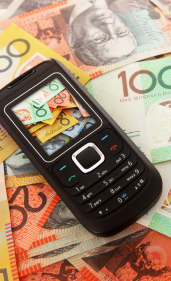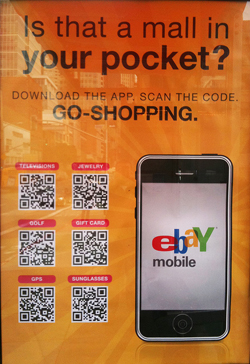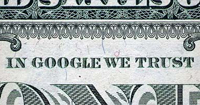How Mobile Shopping is Reinventing the Shopping Experience
This post by Dave Wieneke was recently published on the Econsultancy blog. (Come by and have a look!)
———
Thanks to portability and the ease of use that touch-screen technology has brought to smart phones and tablets, retailers are seeing mobile shopping skyrocket. Mobile commerce (m-commerce) sales in the US in 2008 were $400 million (Source: Mobile Commerce Daily). That number quadrupled to $1.20 billion in 2009. And then doubled to $3.4 billion in 2010 (Source: ABI Research). Growth for 2011 will be nothing but “explosive.”
 Who’s Riding the M-commerce Train
Who’s Riding the M-commerce Train
According to ForeSee Results 2011, a study of nearly 10,000 visitors to the biggest e-retail websites in the US, over half of mobile shoppers used their phones to compare price information (56 percent). Shoppers also used their phones to compare different products (46 percent), to look up product specifications (35 percent), and to view product reviews (27 percent). Who among us hasn’t stood in a bookstore and checked a book’s retail price against Amazon, and perhaps deferred a purchase by adding it to a wish list?
Art Technology Group (ATG) did their own consumer research study and found that 18- to 34-year-olds are the biggest users of mobile devices for shopping. Forty-one percent of respondents said they use mobile devices to browse or research products or services, up from 23 percent reported in another ATG study released earlier in 2010.
And for those of you following tablet computing, here’s the amazing part—visits to retail sites via the iPad outnumber other mobile devices, even the iPhone (source: Forrester Research). Let’s put this in perspective: A device that entered the market just over a year ago is now a leading commerce platform.
So Why the Shift in User Behavior?
In short, the combination of useful apps and easy, instant access to information through mobile devices is integrating computing into new sets of daily tasks in our lives. My earlier post, Did You Take That iPad to Bed With You?, describes this shift and the size of this opportunity in our industry.
 eBay Proves Mobile Makes Sense
eBay Proves Mobile Makes Sense
Perhaps the most well-known example of turning mobile browsers into buyers is eBay. eBay launched its first application for Apple’s iPhone in July 2008 and has since continued to ramp up its mobile commerce initiatives. Its core iPhone application, which is available free via iTunes in eight languages and 190 countries, has been downloaded more than 30 million times and lets users browse and buy without leaving the application (source: www.onlinemarketing-trends.com). The eBay application for the iPad is a free app that delivers a tablet-optimized shopping experience to browse and buy a plethora of auctioned items. eBay’s suite of mobile applications, including Selling, Classifieds, StubHub and Deals, are designed to make selling and buying possible virtually anywhere, anytime.
The strategy works; eBay announced earlier this year that global mobile sales generated nearly $2 billion in 2010, up from $600 million in 2009. Global sales from Nov. 25 to Dec. 25, 2010, were up 166 percent to $230 million from the same period in 2009. So the holiday season was a clear catalyst for much of that growth. While clothing and accessories was a consistently popular category for purchases, cars and trucks led US mobile sales in terms of dollars in 2010 (source: eBay)
The In-store Experience Gets Turned Upside Down
Thanks to a number of new and innovative apps, the traditional brick-and-mortar experience is getting revamped – and for the better, in my opinion.
Comparison Shopping
Consumers have access to a number of apps that allow them to scan product barcodes while in the store to look for pricing and availability at competing online and offline locations. These include apps such as Red Laser, Scandit, and Shop Savvy. Consumers have real-time information that directly impacts their purchase decisions and gives them real bartering capability. For example, I was in the market for a new mattress. I was able to pull up price comparisons for the desired Simmons Beautyrest Luxury Firm mattress, show it to the sales person and ask, “What can you do on your price? I’d like to give you my business, but only if you can be more in line with your competition.” Who wouldn’t sleep better knowing they got the best deal?
Social Commerce
Product recommendations have always been a commerce driver, but with the advent of social networks we’re seeing the rise of “social commerce.” Beyond just reading recommendations and sharing opinions on social networks, retailers are using social networking tools to boost retail sales as a speedier identity and authentication mechanism.
In 2010, social network leader Facebook launched Facebook Connect, a series of plug-ins retailers began using to integrate the social network’s Like button on their sites. It also allows e-commerce operators to give consumers the option to sign in at e-retail sites using their Facebook log-in information, which means consumers can feed information back and forth between the e-retail site and Facebook. According to a survey from social media optimization firm Gigya, two-thirds of online retailers said they offered or planned to offer visitors the ability to use their Facebook log-in on their e-commerce sites.
In-Store Apps
 Retailers are also catching on to the use of applications and SMS programs designed to drive traffic to mobile and in-store destinations. Old Navy recently partnered with Shazam to promote its spring advertising campaign called Old Navy Records. When customers enter any Old Navy location they can use the Shazam application to access exclusive Old Navy deals, styling tips, video and other music content from their handsets. Whenever an Old Navy Records song or video is playing, Shazam users can tag it by holding their mobile device towards where the song is playing. Once tagged, users can get access to key looks featured in the songs.
Retailers are also catching on to the use of applications and SMS programs designed to drive traffic to mobile and in-store destinations. Old Navy recently partnered with Shazam to promote its spring advertising campaign called Old Navy Records. When customers enter any Old Navy location they can use the Shazam application to access exclusive Old Navy deals, styling tips, video and other music content from their handsets. Whenever an Old Navy Records song or video is playing, Shazam users can tag it by holding their mobile device towards where the song is playing. Once tagged, users can get access to key looks featured in the songs.
Mobile Point-of-Sale (The Holy Grail)
With great speculation that 2011 will be the year of the “mobile wallet,” Starbucks, Guess and Disney are all jumping into the mobile point-of-sale (POS) arena. Starbucks’ new app allows customers to manage a Starbucks Card account, check balances, reload a card and check reward status. To make a purchase, shoppers hold the mobile device in front of a scanner on the countertop and scan the Starbucks Card Mobile App’s on-screen barcode.
Guess and Disney will both roll out mobile POS systems this year enabling store staff to use personalized data to assist customers and to execute sales right at the rack. Better client experience + more closed sales + lower set-up costs ($500 vs. $3,500 dedicated register) = $$$ cha ching!
 Just this week, Google announced it is adding near-field payment technology to its Nexus handset. This will turn the mobile device in to an e-wallet and allow consumers to pay by tapping their handsets on one of several thousand Google payment terminals being tested in New York and San Francisco. Look for this platform to take on payment, couponing, even loyalty programs.
Just this week, Google announced it is adding near-field payment technology to its Nexus handset. This will turn the mobile device in to an e-wallet and allow consumers to pay by tapping their handsets on one of several thousand Google payment terminals being tested in New York and San Francisco. Look for this platform to take on payment, couponing, even loyalty programs.
Almost every aspect of the in-store experience has been influenced by mobile technology. And I haven’t even mentioned the proliferation and impact of mobile advertisements, influencing shoppers even before a product need has surfaced. We’re seeing the start of a fully convergent online and in-person shopping experience. In my next post, we’ll visit how this is taking form at one of Europe’s largest food retailers.

 The future of digital experiences will be built by strategists who grasp the full array of emerging business, social, and technical models. Specialties in user experience, branding, application design, and data science are laying the foundation for richer user experiences and business models breakthrough products and revenue based marketing.
The future of digital experiences will be built by strategists who grasp the full array of emerging business, social, and technical models. Specialties in user experience, branding, application design, and data science are laying the foundation for richer user experiences and business models breakthrough products and revenue based marketing.
1 Response to "How Mobile Shopping is Reinventing the Shopping Experience"
May 12, 2016
http://www.realkahani.in Thanks